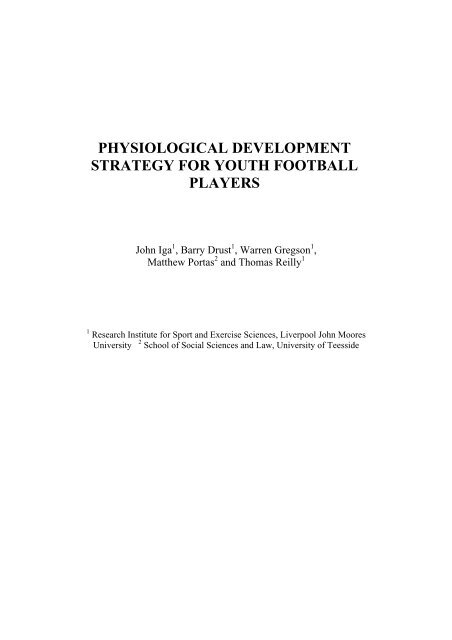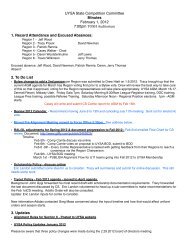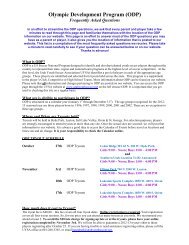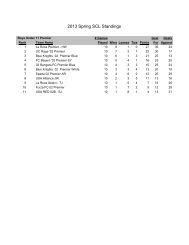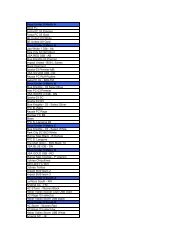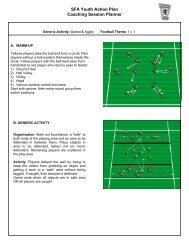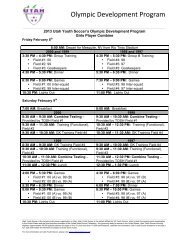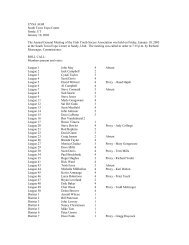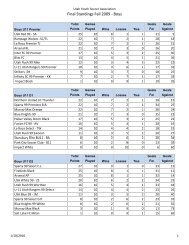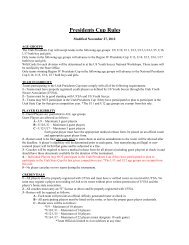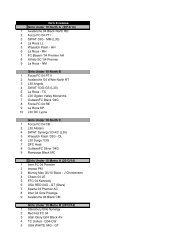physiological development strategy for youth football players
physiological development strategy for youth football players
physiological development strategy for youth football players
- No tags were found...
You also want an ePaper? Increase the reach of your titles
YUMPU automatically turns print PDFs into web optimized ePapers that Google loves.
PHYSIOLOGICAL DEVELOPMENTSTRATEGY FOR YOUTH FOOTBALLPLAYERSJohn Iga 1 , Barry Drust 1 , Warren Gregson 1 ,Matthew Portas 2 and Thomas Reilly 11 Research Institute <strong>for</strong> Sport and Exercise Sciences, Liverpool John MooresUniversity 2 School of Social Sciences and Law, University of Teesside
CONTENTSPreface………………………………………………. 3Introduction…………………………………………. 4Aerobic training...…………………………………... 6Speed endurance training...…………………….…… 9Speed training…….………………………..…….…. 13Strength and power training...……...…………….…. 20Core stability training………………………………. 62Balance, coordination and agility training………….. 74Flexibility training………………………………….. 82Testing and monitoring……………………………… 972
PREFACEThis document is a reflection of interest in science and <strong>football</strong> at Liverpool JohnMoores University. The institution has over 30 years of studying <strong>football</strong>, manifestedin the many doctoral research students that have graduated from it and currently arework within the game. Liverpool John Moores University is also unique in having thefirst undergraduate BSc (Hons) degree in Science and Football. The philosophy ofthe Research Institute <strong>for</strong> Sport and Exercise Sciences is to bridge the gap betweentheory and practice, its fundamental work on training and talent <strong>development</strong> allows<strong>for</strong> application from theory to practice. The principles established can be married toapplied work and translate into practical recommendations. Such conclusions are atthe core of the guidelines set out in this document. The material is prepared <strong>for</strong>personnel working with <strong>youth</strong> <strong>football</strong> <strong>players</strong>. It is the intention that the guidelinesare directly applicable to young <strong>players</strong> going through the <strong>development</strong> process.These guidelines have been set <strong>for</strong> young males but in most instances can be appliedto young females as well.Professor Thomas ReillyDirector of the Research Institute <strong>for</strong> Sport and Exercise Sciences,Liverpool John Moores University.3
INTRODUCTIONThe <strong>development</strong> of young <strong>football</strong> <strong>players</strong> has taken on increasing importance. Toproduce first team <strong>players</strong>, in addition to working on technical and tactical abilities,the <strong>development</strong>al process must also work on a number of other attributes. Theseinclude habits and pass-times, mental skills and physical fitness.Physical fitness in particular has received much attention in recent years. Physicalfitness is composed of several aspects. These aspects are illustrated in Figure 1.Good levels in each of these aspects will allow a player to complete the activities andgame skills needed throughout a match. This makes fitness training an important partof every player’s training schedule. Although the various aspects of fitness can beimproved through appropriate training, research has suggested that there may beoptimal periods within a player’s growth and <strong>development</strong> when it is best to buildupon them. It is possible that if these attributes are not put under sufficient stressduring these ‘windows of opportunity’ a player may not realise his or her fullper<strong>for</strong>mance potential.SpeedEnduranceSpeedAerobicEndurancePowerPhysical FitnessFlexibilityStrengthBalance,Co-ordination& AgilityCoreStabilityFigure 1. Range of fitness parameters <strong>for</strong> <strong>football</strong>.4
This document offers in season training recommendations <strong>for</strong> physical fitness <strong>for</strong><strong>youth</strong> <strong>football</strong> <strong>players</strong>. The guidelines are set out in a systematic manner and aregiven in relation to the maturity of the player (i.e., pre pubertal, pubertal and postpubertal). Considerations in aerobic and speed-endurance training are followed byspecific focus on speed, strength and power training. Core stability training isreviewed prior to a focus on balance, co-ordination, agility and flexibility training.Special attention is then devoted to the assessment and monitoring of <strong>players</strong>.In producing this report we recognise that training time is often limited and coachesmay be reluctant to devote too much of this time on physical conditioning. However,with the ‘smart’ organisation of training several physical, tactical and technicalobjectives can be integrated within the same session. We recommend that, whereverpossible, these training proposals should be applied within technical and tactical drills.For example, by carefully manipulating of the playing dimensions, number of <strong>players</strong>and the game rules, simple ball possessions drills can be used to provide anappropriate training stimulus <strong>for</strong> the <strong>development</strong> of aerobic endurance.These guidelines are endorsed by the Research Institute <strong>for</strong> Sport and ExerciseSciences at Liverpool John Moores University.5
AEROBIC TRAINING6
The aims of aerobic training are to:AEROBIC TRAINING• Increase the ability of the body to transport and use oxygen• Improve the ability to recover after periods of hard exerciseThis will benefit <strong>football</strong> per<strong>for</strong>mance by:• Allowing the body to provide more energy via the aerobic energy systemthereby allowing a player to work at a higher intensity during the game• Reducing the recovery time that is required after intense periods of play be<strong>for</strong>e<strong>players</strong> can per<strong>for</strong>m another hard ef<strong>for</strong>t• Reducing the loss of technical skill per<strong>for</strong>mance that often accompaniestirednessTraining Prescription <strong>for</strong> Aerobic TrainingBe<strong>for</strong>e puberty there is no need to complete any specific aerobic endurance training,as the activities completed during practice will improve the aerobic fitness of the<strong>players</strong>.After puberty <strong>players</strong> will benefit from a more structured approach to training.Aerobic training <strong>for</strong> <strong>players</strong> at this stage of <strong>development</strong> should be based around the“Smart” principle (i.e., structuring technical training in a way that benefits theplayer’s physical fitness as well as their technical skill). This type of training is veryeffective as it is very efficient in terms of training time. It is also very specific to<strong>football</strong>. This ensures that any improvements in match per<strong>for</strong>mance related totraining are optimised.Tables 1 and 2 provide you with relevant in<strong>for</strong>mation <strong>for</strong> the organisation of “Smart”training sessions that will develop the aerobic energy system. These guidelinesshould be used to help structure the intensity and the length of your exercise andrecovery periods during your sessions.Table 1. Guidelines <strong>for</strong> aerobic training <strong>for</strong> <strong>players</strong> in the early stages ofpubertyIntensityLength ofExercise PeriodLength ofRecoveryPeriodRatio ofExercise toRecoveryRepetitions65 – 90 % 1 – 2 min 1 – 2 min 1:1 4 – 5HR Max 11 HR Max refers to the maximal heart rate of the player7
Table 2. Guidelines <strong>for</strong> aerobic training <strong>for</strong> post pubertal <strong>football</strong> <strong>players</strong>Type ofTrainingIntensityLength ofExercisePeriodLength ofRecoveryPeriodRatio ofExercise toRecoveryRepetitionsAerobic Low 65 – 90 %HR Max2 – 4 min 1 – 2 min 2:1 4 – 5Aerobic High 80 – 100 %HR Max30 – 120 s 30 – 120 s 1:1 1 – 3 sets of3 – 5 repsAs you can see aerobic training should become more specialised as the <strong>players</strong>develop with a need to include both low (Aerobic Low ) and high intensity (Aerobic High )aerobic training. These two different types of training ensure that all the aims ofaerobic training (listed above) are obtained.When you start to use these tables to structure your training you should always use thelower value given in the boxes first (e.g., 2 min not 3 min). As your <strong>players</strong> becomeused to this type of exercise you should increase the demands placed on them bymoving towards the higher values. These increases should be done in stages (e.g., 2min increased to 2 min 30 s followed by increases to 3 min) to prevent the newtraining load being too hard <strong>for</strong> the player.Do not rush the progress of your sessions, as all <strong>players</strong> will take time to adapt to anynew training programme. If you try to progress too quickly your player’sper<strong>for</strong>mance will become worse not better and your training will not be effective.You can gradually increase most of the variables given in the table, such as theintensity, the lengths of the exercise and recovery periods and the number ofrepetitions. Changes to the length of the exercise period should be linked to changesin the length of the recovery period so you do not change the ratio of exercise torecovery.When adapting your training prescription it is good to change the variables in thefollowing order: -1. Intensity of Exercise2. Length of Exercise Period3. Number of RepetitionsMake sure you do not extend your training prescription beyond the guidelinesprovided as this may lead to inappropriate amounts of physical stress being placed onyour <strong>players</strong>. This could lead to them becoming injured or overtrained.8
SPEED ENDURANCE TRAINING9
SPEED ENDURANCE TRAININGThe aims of speed endurance training are to:• Increase the ability to produce energy through the anaerobic energy systems• Improve the ability to recover after high intensity ef<strong>for</strong>tsThis will benefit <strong>football</strong> per<strong>for</strong>mance by:• Improving the per<strong>for</strong>mance of intense match activities such as sprinting• Increasing the amount of high intensity exercise periods that can be per<strong>for</strong>medin a match• Increasing the length of time that high intensity ef<strong>for</strong>ts can be maintainedTraining Prescription <strong>for</strong> Speed Endurance TrainingThere is no need to complete any specific speed endurance training with <strong>players</strong> whohave not yet reached puberty, as the activity completed during training will, to someextent, improve speed endurance.After puberty <strong>players</strong> will benefit from a more structured approach to speedendurance training. Speed endurance training <strong>for</strong> <strong>players</strong> at this stage of <strong>development</strong>should be based around the “Smart” principle (i.e., structuring technical training in away that benefits the player’s physical fitness as well as their technical skill). Thistype of training is very effective as it is very efficient in terms of training time. It isalso very specific to <strong>football</strong>. This ensures that any improvements in matchper<strong>for</strong>mance related to the training are optimised.Tables 3, 4 and 5 provide you with relevant in<strong>for</strong>mation <strong>for</strong> the organisation of“Smart” training sessions that will develop speed endurance. These guidelines shouldbe used to help structure the intensity and the length of your exercise and recoveryperiods during your sessions.Table 3. Guidelines <strong>for</strong> speed endurance training <strong>for</strong> <strong>players</strong> in the early stagesof pubertyIntensityLength ofExercisePeriodLength ofRecoveryPeriodRatio ofExercise toRecoveryRepetitionsAlmostMaximal20 – 60 s 20 – 60 s 1:1 2 – 610
Table 4. Guidelines <strong>for</strong> speed endurance training <strong>for</strong> <strong>players</strong> in the late stages ofpubertyIntensityLength ofExercisePeriodLength ofRecoveryPeriodRatio ofExercise toRecoveryRepetitionsAlmostMaximal30 – 90 s 30 – 90 s 1:1 2 – 10Table 5. Guidelines <strong>for</strong> speed endurance training <strong>for</strong> post pubertal <strong>football</strong><strong>players</strong>Type ofTrainingIntensityLength ofExercisePeriodLength ofRecoveryPeriodRatio ofExercise toRecoveryRepetitionsProductionAlmostMaximal30 – 90 s 30 – 90 s 1:1 2 – 10MaintenanceAlmostMaximal20 – 40 s 100 – 200 s 1:5 2 – 10Speed endurance training should become more specialised when the <strong>players</strong> reachpost puberty. At this stage <strong>players</strong> should complete both “Production” and“Maintenance” training. Including these two different types of training ensure that allthe aims of speed endurance training (listed above) are obtained.When you start to use these tables to structure your training you should always use thelower value given in the boxes first (e.g., 30 s not 90 s). As your <strong>players</strong> become usedto the exercise you should increase the demands placed on them by moving towardsthe higher values. These changes should be done in stages (e.g., 30 s increased to 45 sfollowed by increases to 60 s) so any increases are not too large.Don’t rush the progress of your sessions, as all <strong>players</strong> will take time to adapt to anytraining programme. If you try to progress too quickly your player’s per<strong>for</strong>mance willbecome worse not better. It is also very important that this type of work is per<strong>for</strong>medat the correct intensity. If you try and increase the training load too quickly theintensity of training that you need will be lost and your session will not achieve thedesired effects.11
You can gradually increase most of the variables given in the table such as the lengthsof the exercise and recovery periods and the number of repetitions. Changes to thelength of the exercise period should be accompanied by changes in the length of therecovery period so that the ratio of exercise to recovery is not changed.When adapting your training prescription it is good to change the variables in thefollowing order: -1. Length of Exercise Period2. Number of RepetitionsMake sure you do not extend your training prescription beyond the guidelinesprovided as this may lead to inappropriate amounts of physical stress being placed onyour <strong>players</strong>. This could lead to injury and overtraining.12


